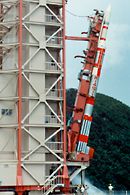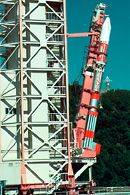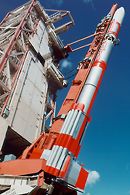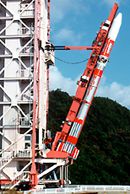The Age of Space Science ---- Mu Rockets
Then came the age of the M (Mu) rocket. ISAS has proceeded
step by step by improving the launch performance of the Mu rocket series.
The history of Mu reflects the process by which Japanese space science
has established its position in the global academic society.
 |
M-4S
The first generation was the four-stage M-4S type. The M-4S adopted
the gravity-turn method as a payload injection scheme, and stabilized
the attitude by tail fins and spin. Following the launch of a technological
test satellite TANSEI in February 1971, ISAS succeeded in orbiting
two full-fledged scientific satellites, SHINSEI and DENPA, in September
1971 and August 1972, respectively by means of the M-4S. |
 |
M-3C
The second generation, M-3C, had three stages. Both 2nd and 3rd stages
were newly developed, with the 2nd stage incorporating SITVC (secondary
injection thrust vector control) and SJ (side jet) systems to improve
orbit-injection accuracy. The M-3C sent three satellites into orbit:
TANSEI 2, TAIYO and HAKUCHO in February 1974, 1975 and 1979 respectively. |
 |
M-3H
ISAS next developed the third generation, M-3H, by extending the length
of the first stage motor with improved propellant to achieve a greater
payload capability. The M-3H carried three satellites into orbit around
earth: TANSEI 3, KYOKKO, and JILIKEN in February 1977, February 1978,
and September 1978 respectively. |
 |
M-3S
The fourth generation of Mu vehicle named the M-3S introduced a thrust
vector control (TVC) system to the 1st stage, too, to improve the
launch accuracy and ease restrictions on launch conditions. The M-3S
successfully launched four satellites: TANSEI 4, HINOTORI, TENMA and
OHZORA in February of 1980, 1981, 1983 and 1984 respectively. |
|


|
|